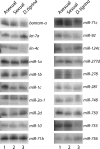MicroRNAs from the Planarian Schmidtea mediterranea: a model system for stem cell biology
- PMID: 16849698
- PMCID: PMC1557691
- DOI: 10.1261/rna.117206
MicroRNAs from the Planarian Schmidtea mediterranea: a model system for stem cell biology
Abstract
MicroRNAs (miRNAs) are approximately 22-nt RNA molecules that typically bind to the 3' untranslated regions of target mRNAs and function to either induce mRNA degradation or repress translation. miRNAs have been shown to play important roles in the function of stem cells and cell lineage decisions in a variety of organisms, including humans. Planarians are bilaterally symmetric metazoans that have the unique ability to completely regenerate lost tissues or organs. This regenerative capacity is facilitated by a population of stem cells known as neoblasts. Planarians are therefore an excellent model system for studying many aspects of stem cell biology. Here we report the cloning and initial characterization of 71 miRNAs from the planarian Schmidtea mediterranea. While several of the S. mediterranea miRNAs are members of miRNA families identified in other species, we also identified a number of planarian-specific miRNAs. This work lays the foundation for functional studies aimed at addressing the role of these miRNAs in regeneration, cell lineage decisions, and basic stem cell biology.
Figures




Similar articles
-
Small RNA pathways in Schmidtea mediterranea.Int J Dev Biol. 2012;56(1-3):67-74. doi: 10.1387/ijdb.113436ar. Int J Dev Biol. 2012. PMID: 22450996 Review.
-
Deep sequencing identifies new and regulated microRNAs in Schmidtea mediterranea.RNA. 2009 Aug;15(8):1483-91. doi: 10.1261/rna.1702009. Epub 2009 Jun 24. RNA. 2009. PMID: 19553344 Free PMC article.
-
Identification of small non-coding RNAs in the planarian Dugesia japonica via deep sequencing.Genomics. 2012 May;99(5):315-21. doi: 10.1016/j.ygeno.2012.03.001. Epub 2012 Mar 8. Genomics. 2012. PMID: 22425900
-
Identification of neoblast- and regeneration-specific miRNAs in the planarian Schmidtea mediterranea.RNA. 2013 Oct;19(10):1394-404. doi: 10.1261/rna.038653.113. Epub 2013 Aug 23. RNA. 2013. PMID: 23974438 Free PMC article.
-
Histone modifications and regeneration in the planarian Schmidtea mediterranea.Curr Top Dev Biol. 2014;108:71-93. doi: 10.1016/B978-0-12-391498-9.00004-8. Curr Top Dev Biol. 2014. PMID: 24512706 Review.
Cited by
-
Deep sequencing reveals unique small RNA repertoire that is regulated during head regeneration in Hydra magnipapillata.Nucleic Acids Res. 2013 Jan 7;41(1):599-616. doi: 10.1093/nar/gks1020. Epub 2012 Nov 19. Nucleic Acids Res. 2013. PMID: 23166307 Free PMC article.
-
Role of Fasciola hepatica Small RNAs in the Interaction With the Mammalian Host.Front Cell Infect Microbiol. 2022 Jan 20;11:812141. doi: 10.3389/fcimb.2021.812141. eCollection 2021. Front Cell Infect Microbiol. 2022. PMID: 35155272 Free PMC article.
-
Dynamic Changes in the Global Transcriptome and MicroRNAome Reveal Complex miRNA-mRNA Regulation in Early Stages of the Bi-Directional Development of Echinococcus granulosus Protoscoleces.Front Microbiol. 2020 Apr 9;11:654. doi: 10.3389/fmicb.2020.00654. eCollection 2020. Front Microbiol. 2020. PMID: 32373094 Free PMC article.
-
microRNAs of parasitic helminths - Identification, characterization and potential as drug targets.Int J Parasitol Drugs Drug Resist. 2014 Mar 24;4(2):85-94. doi: 10.1016/j.ijpddr.2014.03.001. eCollection 2014 Aug. Int J Parasitol Drugs Drug Resist. 2014. PMID: 25057458 Free PMC article. Review.
-
Conservation and diversification of small RNA pathways within flatworms.BMC Evol Biol. 2017 Sep 11;17(1):215. doi: 10.1186/s12862-017-1061-5. BMC Evol Biol. 2017. PMID: 28893179 Free PMC article.
References
-
- Adoutte A., Balavoine G., Lartillot N., de Rosa R. Animal evolution. The end of the intermediate taxa? Trends Genet. 1999;15:104–108. - PubMed
-
- Ambros V. The functions of animal microRNAs. Nature. 2004;431:350–355. - PubMed
-
- Aravin A.A., Lagos-Quintana M., Yalcin A., Zavolan M., Marks D., Snyder B., Gaasterland T., Meyer J., Tuschl T. The small RNA profile during Drosophila melanogaster development. Dev. Cell. 2003;5:337–350. - PubMed
-
- Bagga S., Bracht J., Hunter S., Massirer K., Holtz J., Eachus R., Pasquinelli A.E. Regulation by let-7 and lin-4 miRNAs results in target mRNA degradation. Cell. 2005;122:553–563. - PubMed
Publication types
MeSH terms
Substances
LinkOut - more resources
Full Text Sources
Medical
Research Materials
